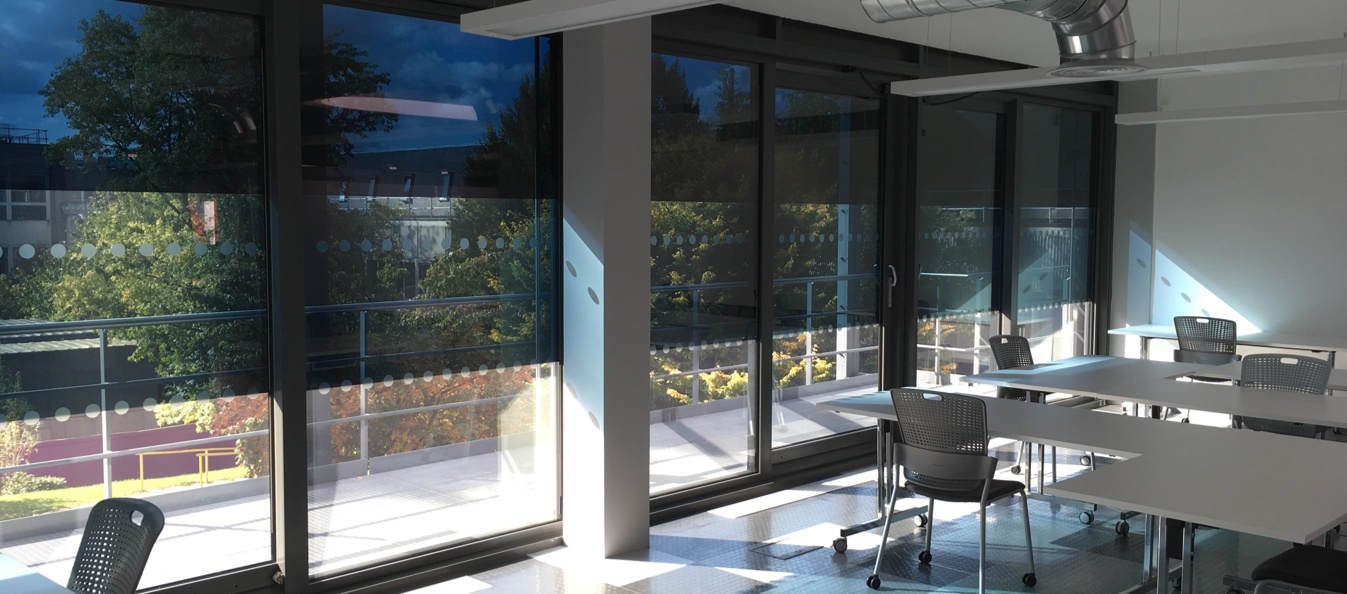Insights
The daylight-shading dichotomy.
My research into smart glazing.
Our cities are full of highly glazed buildings. We love to build with glass because we find its transparency hugely appealing; it allows lots of daylight in and views out.
However, glass buildings are associated with some familiar problems: glare and overheating.
Shading is required to address these issues, and this is typically achieved by adding a physical layer to the facade. The problem with shading is that it is often added as an afterthought, and detracts from the aesthetic advantages of the glass façade.
People leave blinds in the same position for weeks or even months, essentially cutting themselves off from the benefits of the glazing – daylight and the connection to the outside world. It’s not good news from an energy consumption point of view either, because if the blinds are down, the lights are on.
A smart solution
Smart glazing can change its optical properties in response to an external stimulus, bringing the benefits of dynamic shading and automated control. One such material, electrochromic glazing, has become a viable fenestration material and several commercially available products have appeared in recent years.
 Electrochromic glazing at the Keith Green architecture building, Loughborough University. Reproduced with permission from Saint Gobain.
Electrochromic glazing at the Keith Green architecture building, Loughborough University. Reproduced with permission from Saint Gobain.
Smart glazing could be a solution to the daylight-shading dichotomy, because it has the characteristics of a moveable shading system but without the need for visually obtrusive elements or mechanical moving parts. The glazing provides shading for both overheating and glare in one solution.
You could say that it enables you to have your daylight cake and eat it.
It’s all about the user
I conducted a study into the long-term user experience of electrochromic glazing as part of my PhD research.
My work was on the first smart glazing installation of its kind in the UK. It was installed in two office rooms in a university campus building, and over a period of 18 months we monitored both the physical conditions in the rooms and gathered user feedback.
One of my key findings was that, for office workers such as those in my study, it is important to first understand their shading needs both as individuals and as a group in a shared space. As with any shading conversation, seating position relative to the façade is paramount, and ideally should be based on an understanding of occupants’ needs as individuals. Unfortunately, we don’t often get the opportunity to meet the people who are going to occupy the buildings we design, particularly when designing speculative offices. Nonetheless, I strongly feel that we need to start bridging that gap in understanding if we want to create successful buildings.
Ultimately, the well-worn adage that you can’t please all of the people all of the time holds true. Electrochromic glazing has been shown to reduce glare and overheating for most users, but the experience of glare is highly subjective and out individual sensitivity to it varies enormously. Furthermore, electrochromic glazing has aesthetic properties that makes it unsuitable for some buildings.
There is also an important distinction between the acceptance of new technologies in a refurbishment (as was the case in my research project) and a new-build. In the latter scenario, occupants are more likely to accept new technologies in the wider schema of a brand-new building.
During my research I came to realise that what really matters are not the just physical effects of technology like this, but whether users are happy with their environment.
Through this experience, I am acutely aware that the satisfaction of occupants is the key to success in daylight design, and this is true whether or not it involves implementing a novel technology like electrochromic glazing. Clearly, energy demand reduction is a huge driver, but occupants have a crucial role to play in ensuring that systems that are designed to save energy are used as intended in the building. By staying focussed on the needs of the occupants, we develop beautiful and functional daylight and shading solutions that will be appreciated by the people who inhabit the building.
